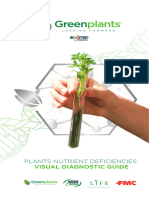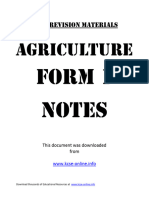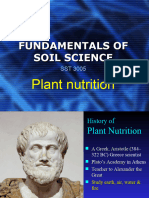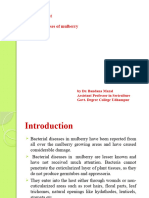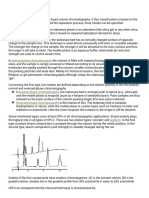0 ratings0% found this document useful (0 votes)
6 viewsUnit 5.2
Uploaded by
ashwinbhutyalCopyright
© © All Rights Reserved
Available Formats
Download as PPTX, PDF, TXT or read online on Scribd
0 ratings0% found this document useful (0 votes)
6 viewsUnit 5.2
Uploaded by
ashwinbhutyalCopyright
© © All Rights Reserved
Available Formats
Download as PPTX, PDF, TXT or read online on Scribd
You are on page 1/ 17
5.
2: Source of Nutrient Elements in Soil
and Their Role in Plant Growth Including
their Deficiency and Toxicity
By: Dr. Jyoty Angotra(Lecturer)
Govt. Degree College, Poonch.
Minerals: Minerals are chemical
elements required as a essential
nutrient by organisms to perform
functions necessary for life. Plants gets
minerals from the soil; they absorb
dissolve elements from soil which are
helpful for their growth and
development.
Classification: Approximately 16 element
are stated to be essential to the growth of
most plants, depending upon the quantity
of requirement, essential elements are sub
divided into two groups:
MACROELEMENTS
MICROELEMENTS
Macro elements: Those elements which
are needed in large quantities. It includes
carbon, hydrogen, oxygen, nitrogen,
potassium, phosphorus, calcium, sulphur,
magnesium etc., total 9 elements.
Micro elements: Those elements which
are needed in small quantities. It includes
chlorine, iron, manganese, boron, zinc,
copper, molybdenum.
Minerals Deficiency Symptoms and
Reclamations
Deficiency "lack or storage": It may be defined as
something that is lacking or something that is not
sufficient is known as deficiency.
Symptoms: a physical features which is regarded as
indicating a condition of disease particularly such a
feature i,e apparent to the patient.
Reclamation: the act or the process of recovery the
reclamations start from soil up-to the mulberry.
Nitrogen:
Macro-Nutrients
Nitrogen constitutes an important element in the
composition of the plants and it is an essential constituent
of proteins, nucleic acid, vitamins, and many other
organic molecules such as chlorophyll.
Role: It play a important role for cell division, it also
involve in photosynthesis, It is a building block of protein.
Nitrogen Deficiency Symptoms: Stunted growth,
Retarded growth of roots, Reduction in the size of
branches and stunted appearance of the plant indicate
deficiency of soil nitrogen, Premature leaf fall and
yellowing of leaf. Reclamation: Application of
nitrogenous fertilizers likes urea, ammonium nitrate,
potassium nitrate or calcium nitrates correct the
deficiency symptoms.
Macro-Nutrients
Phosphorus: Phosphorus is present plasma
membrane and it is a component of nucleic acid,
nucleotide, many co enzyme and organic molecules.
Role: It play a important role in energy metabolism, it
promote healthy root growth and fruit ripening.
Phosphorus Deficiency Symptoms: The earliest
sign noticeable was interveinal chlorosis of older
leaves which spread rapidly to the whole leaf, stunted
and slender stem, discoloration of stem and leaves to
reddish or purplish color, poor growth.
Reclamation: Application of phosphate fertilizers
like triple phosphate or super phosphate.
Macro-Nutrients
Potassium: It is a third important element, next to
importance in nitrogen and phosphorus, potassium is
required in the meristimatic region and region of cell
differentiation.
Role: It plays an important role in the activation of many
enzyme and has a role in protein and carbohydrate
metabolism.
Potassium Deficiency Symptoms: Weaker stem and
root system, small leaves, young leaves with scorched
margins and coarse, non juicy and necrotic leaves indicate
potassium deficiency.
Reclamation: Application of potash fertilizer to correct
the deficiency.
Macro-Nutrients
Calcium: It forms an important constituent of the cell wall
occurring in the middle lamella as calcium pectate.
Role: It has an important role in mitotic division and is a
constituent of enzyme like phospholipase and adenly kinase
where it acts as an activator. It reduces the harm full action of
iron and manganese to plants.
Calcium Deficiency Symptoms: The first sign of this deficiency
is necrosis along the veins and this in the later stage leads to the
abscission of the leaves, the plants show stunted growth with
woody stem and yellowish of tips, leaf shape disordered.
Reclamation: Application of lime in the recommended dose
after soil testing i.e., 1 MT/ha/year at the interval of every 4-5
years. Spray 0.5-1.0% calcium nitrate or calcium chloride over the
leaves of deficient plants.
Macro-Nutrients
Sulphur: It involve in the formation of chlorophyll and
glycosides and in the activation of enzyme. It is the
constituent of certain vitamins such as thiamine and
biotin.
Role: It plays an important role in respiration.
Sulphur Deficiency Symptoms: Younger leaves show
chlorosis first, overall growth of plant is stunted with
general lack of new growth, Necrosis starts from the
margin in younger leaves.
Reclamation:0.1-0.2% aqueous solution of potassium
sulphate should be sprayed on deficient
plants,ammonium sulphate or gypsum has to be applied
in the recommended doses.
Macro-Nutrients
Mangnesium: Magnesium is a constituent of chlorophyll
molecule which can't be formed without magnesium.
Role: It is a vital role in carbohydrate metabolisms and
the binding of ribosomal subunit. Magnesium is the
activator of many enzyme involved in DNA and RNA
synthesis.
Magnesium Deficiency Symptoms: Interveinal
chlorosis takes place, Spots of the dead tissues scattered
over the young leaf.
Reclamation: Application of magnesium sulphate or
magnesium oxide to the soil, Use of a folair sprays 2%
solution of magnesium sulphate, Spray magnesium
sulphate of 0.2- 0.5% on deficient plants.
Micro-nutrient
Copper: Copper is necessary for chlorophyll
formation in plants and catalyses several other plant
reactions although it is not usually a part of the
product formed by that reaction.
Copper Deficiency Symptoms: It includes wilting of
tender leaves and drying of leaf tips without any
change in color of the leaves and Excess of copper
leads to death of bark.
Reclamation: Aqueous solution of 1kg copper
sulphate/ha/crop should be spray over plants.
Micro-nutrient
Iron: This is an important constituent of many enzymes,
particularly the respiration enzyme. It is also essential for
chlorophyll.
Role: It plays an important role in the electron transport
system of photosynthesis.
Iron Deficiency Symptoms: Iron deficiency shows up as a
pale green leaf color with sharp distinction between green
veins and yellow interveinal tissues, fruits trees particularly
show sensitivity to iron deficiency.
Reclamation: To recover this deficiency appropriate dose of
iron sulphate or use of iron- chelating compound as foliar
recommended.
Micro-nutrient
Zinc: It is necessary for the formation of
carbohydrates and starch.
Zinc Deficiency Symptoms: Overall plant growth is
arrested, Lower leaves become yellowish green, Severe
reduction in leaf size, Whitish spot appears on the
older leaves, decrease in auxin content.
Reclamation: Aqueous solution of 2kg zinc
sulphate/ha/crop should be sprayed over the leaves of
deficient mulberry plants and excess of zinc salts
injuries the root and dwarf the plants.
Micro-nutrient
Boron: The role of boron in mulberry is unknown but
it appears to be in the translocation of sugar and
utilization of calcium in cell wall formation.
Boron Deficiency Symptoms: Yellowing and death
of the terminal buds and blackening of the plants,
include stunted growth, abnormal shape and
disintegration of young tissue which leads to cracks in
the plants.
Reclamation: Application of borax in appropriate
doses corrects the deficiency.
Micro-nutrient
Chloride: Not much information about its function,
it enhance maturity of small grains on some soil.
Chloride Deficiency Symptoms: Leave wilt,
Chlorosis and necrosis. Yellowing of leaves and slow
death of the tips.
Reclamation: Application of fertilizers for recovery.
Thank You
You might also like
- Marijuana Garden Saver: A Field Guide to Identifying and Correcting Cannabis ProblemsFrom EverandMarijuana Garden Saver: A Field Guide to Identifying and Correcting Cannabis ProblemsNo ratings yet
- Plants and Animals Nutrition General BiologyNo ratings yetPlants and Animals Nutrition General Biology11 pages
- Role of Mineral Nutrition in Plants, Deficiency Symptoms and Control MeasuresNo ratings yetRole of Mineral Nutrition in Plants, Deficiency Symptoms and Control Measures34 pages
- An Assignment On: " Uidelines For Micronutrient Management"No ratings yetAn Assignment On: " Uidelines For Micronutrient Management"11 pages
- Essential Plant Nutrients and Their Functions: NitrogenNo ratings yetEssential Plant Nutrients and Their Functions: Nitrogen4 pages
- Essential Elements Needed For Plant GrowthNo ratings yetEssential Elements Needed For Plant Growth9 pages
- A Step by Step Guide To Nutrient Deficiency Symptoms in PlantsNo ratings yetA Step by Step Guide To Nutrient Deficiency Symptoms in Plants9 pages
- Unit II Soil Fertility and Productivity PDFNo ratings yetUnit II Soil Fertility and Productivity PDF20 pages
- Soil Science - Plant Nutrient Defi SymptomsNo ratings yetSoil Science - Plant Nutrient Defi Symptoms21 pages
- Lesson Five - Nutrient Requirements and TestingNo ratings yetLesson Five - Nutrient Requirements and Testing45 pages
- Unit 2 Plant Nutrition Mineral RequirementsNo ratings yetUnit 2 Plant Nutrition Mineral Requirements16 pages
- 1.1 The Purpose of Research 1.2 The Basic of TheoryNo ratings yet1.1 The Purpose of Research 1.2 The Basic of Theory3 pages
- 20 Nutrient and Fertilizer PLANT NUTRIENTSNo ratings yet20 Nutrient and Fertilizer PLANT NUTRIENTS29 pages
- .Ph-Just A Look Visual Symptoms of Nutrient Deficiencies in Plants and How To Treat Them100% (1).Ph-Just A Look Visual Symptoms of Nutrient Deficiencies in Plants and How To Treat Them8 pages
- The Hidden Deficiency Uncovering the Health Impacts of Mineral ShortagesFrom EverandThe Hidden Deficiency Uncovering the Health Impacts of Mineral ShortagesNo ratings yet
- NOTIFICATION - NO. - 1842 - RR - RC (Application Date Extended)No ratings yetNOTIFICATION - NO. - 1842 - RR - RC (Application Date Extended)1 page
- Formulation and Manufacturing Process Of: Cosmetics With PackagingNo ratings yetFormulation and Manufacturing Process Of: Cosmetics With Packaging59 pages
- Types of HPLC: Ion-Exchange ChromatographyNo ratings yetTypes of HPLC: Ion-Exchange Chromatography2 pages
- Berger Paints MSDS DataSheet-15032022050028No ratings yetBerger Paints MSDS DataSheet-1503202205002812 pages
- Solutions-Beastchemist Marks Booster Challenge #1No ratings yetSolutions-Beastchemist Marks Booster Challenge #1159 pages
- RTS Chemistry SPM Question Bank Chapter 10No ratings yetRTS Chemistry SPM Question Bank Chapter 108 pages
- Worksheet 12.3 - Limiting and Excess ReactantsNo ratings yetWorksheet 12.3 - Limiting and Excess Reactants1 page
- Testing Chemical Properties of Substances Lab ReportNo ratings yetTesting Chemical Properties of Substances Lab Report2 pages
- AYÒOLÁ Ayòdèjì Ayòdélé (PH.D) : Curriculum VitaeNo ratings yetAYÒOLÁ Ayòdèjì Ayòdélé (PH.D) : Curriculum Vitae7 pages
- Pharmaceutical Development: Lynda PaleshnuikNo ratings yetPharmaceutical Development: Lynda Paleshnuik57 pages
- Niir Complete Technology Book On Detergents 2nd Revised EditionNo ratings yetNiir Complete Technology Book On Detergents 2nd Revised Edition11 pages
- Marijuana Garden Saver: A Field Guide to Identifying and Correcting Cannabis ProblemsFrom EverandMarijuana Garden Saver: A Field Guide to Identifying and Correcting Cannabis Problems
- Role of Mineral Nutrition in Plants, Deficiency Symptoms and Control MeasuresRole of Mineral Nutrition in Plants, Deficiency Symptoms and Control Measures
- An Assignment On: " Uidelines For Micronutrient Management"An Assignment On: " Uidelines For Micronutrient Management"
- Essential Plant Nutrients and Their Functions: NitrogenEssential Plant Nutrients and Their Functions: Nitrogen
- A Step by Step Guide To Nutrient Deficiency Symptoms in PlantsA Step by Step Guide To Nutrient Deficiency Symptoms in Plants
- 1.1 The Purpose of Research 1.2 The Basic of Theory1.1 The Purpose of Research 1.2 The Basic of Theory
- .Ph-Just A Look Visual Symptoms of Nutrient Deficiencies in Plants and How To Treat Them.Ph-Just A Look Visual Symptoms of Nutrient Deficiencies in Plants and How To Treat Them
- The Hidden Deficiency Uncovering the Health Impacts of Mineral ShortagesFrom EverandThe Hidden Deficiency Uncovering the Health Impacts of Mineral Shortages
- NOTIFICATION - NO. - 1842 - RR - RC (Application Date Extended)NOTIFICATION - NO. - 1842 - RR - RC (Application Date Extended)
- Formulation and Manufacturing Process Of: Cosmetics With PackagingFormulation and Manufacturing Process Of: Cosmetics With Packaging
- Testing Chemical Properties of Substances Lab ReportTesting Chemical Properties of Substances Lab Report
- Niir Complete Technology Book On Detergents 2nd Revised EditionNiir Complete Technology Book On Detergents 2nd Revised Edition





























